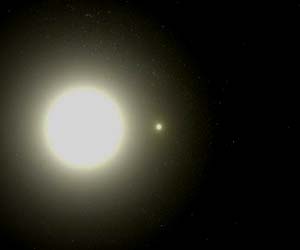Polaris Star Facts

The bright supergiant Polaris with one of its smaller companion stars.
- Polaris is approximately 430 light years from Earth and is the brightest star in the constellation of Ursa Minor.
- Polaris is a three star system comprising of the supergiant Polaris A and two smaller companions.
- The two companion stars, Polaris Ab and Polaris B, are both yellow-white dwarfs with similar surface temperatures to their giant neighbor.
- Polaris Ab is around 2 billion miles (3.2 billion km) from Polaris, Polaris B orbits at a distance of around 240 billion miles (389 billion km).
- A further two distant stars may be associated with Polaris, which would make it a five star system.
- Polaris is the only star in the night sky that appears to remain stationary, this is because it is currently positioned above the northern axis of Earth's rotation.
- As the star always points north it has been an aid to navigators for centuries, although it is only visible in the northern hemisphere.
- Polaris has been aligned above the North Pole for around 2,000 years but after 2100 Earth's northern axis will begin to move away from the star.

To find Polaris draw a line through the outer bowl of the Big Dipper.
Polaris Radius
Polaris is a white supergiant star with a radius of around 22 million miles (35 million km), which is around fifty times the size of the sun.
Polaris Mass
Polaris is estimated to have a mass of around 4.5 times greater than that of the sun.
Polaris Temperature
Polaris has surface temperatures of around 5,700C (10,300F), which is similar to the surface temperature of the sun.
Polaris Luminosity (energy emitted)
Due to its larger surface area Polaris has a luminosity around 2,500 times greater than that of our sun.
Polaris Statistics
Also Known As: Polaris A, Alpha Ursae Minoris, Pole Star, North StarDistance From Earth: 430 light years
Constellation: Ursa Minor
Star Type: F Class Supergiant
Mass: 4.5 x Sun
Luminosity: 2,500 x Sun
Diameter: 44 million miles (70 million km) - 50 x Sun
Temperature: 5,700C (10,300F)
Age: Unknown
Rotation Period: 119 days